Capture your research with a click.
The Graduate Research Photo Competition provides an opportunity to win a cash award, the prestige of having your photo displayed at the Graduate Student Commons in the Valley Library, and bragging rights!
This contest is open to all currently enrolled Oregon State University master’s or doctoral graduate students in both thesis and course-based programs.
Graduate Students can submit a maximum of one photo per competition year. In addition to your photo submission, please provide the following information through the online submission form.
The abstract must explain your photo to a general audience outside of your field of study!
Selected entries will have the abstract printed and displayed with the photo.
To be considered in the competition, all submissions must be:
Note: The Graduate School is required to report all awards to the Office of Financial Aid, which may have an impact on your current financial aid award, if applicable.
First place = $500
Second place = $250
Third place= $100
Top finalists will be chosen by the committee two weeks prior to the first day of Grad Appreciation Week. Graduate Students will be able to vote for their favorite photo from April 5 to April 12. Winners will be announced during Grad Appreciation Week.
The judging committee will utilize this rubric when selecting the top finalists. Please be aware that by submitting a photo, you agree that the Graduate School and the Valley Library has permission to print your photo if chosen for display in Heckart Lodge or The Graduate Student Commons.
Parkrose: A Community Archive
Jada Krening, M.S. student, College of Liberal Arts
In northeast Portland, near the Columbia River and the Portland International Airport and nestled between interstates 205 and 84, lies Parkrose. The now-industrialized urban corner of the city is home to wide plots of land and expansive views of Oregon’s natural features. The community, which sits on the periphery of downtown Portland, was marketed in the early twentieth century as an agricultural suburb for middle-class Portlanders. Today, Parkrose is one of the most racially and ethnically diverse communities in Oregon as a result of urban renewal, gentrification, and the displacement of BIPOC communities throughout Portland in the middle decades of the twentieth century. I was born and raised in Parkrose and have always been struck by its exclusion in historical and contemporary conversations about Portland. My capstone project, Parkrose Community Archive, is my effort to rectify this invisibility. The project is an online community archive that details Parkrose’s neglected history through essays, oral history interviews, images, archival documents, and ephemera. In my pursuit of gathering these materials for a website, I’ve explored the historical founding of Parkrose, which illuminates the deep-seated legacies of colonialism in Oregon; analyzed the impacts of local, state, and federal policymaking; and collaborated with community members willing to share their stories and materials in the name of a publicly accessible historical resource on Parkrose. Parkrose Community Archive is a site for the creation of new knowledge about Portland’s history and an educational tool that Portlanders and Oregonians alike can utilize to learn about this corner of the state’s history.
Ag-Robots in Perspective
Alejandro Velasquez, Ph.D. student, College of Engineering
A fruit-harvesting robotic manipulator is depicted with a commercial Envy apple orchard in the background. The image aims to capture both the complexity of technology with the robot in the foreground and the beauty of nature with the orchard’s vanishing point. While skilled human workers collected thousands of apples, our robot strives to pick a few — not to mention all the data and power lines connected to it and the Ph.D. students cheering behind the stage — reminding us of the long journey that still needs to be undertaken before machines can work alongside humans. From localizing the fruit to approaching it and picking it, selective fruit harvesting is a task that prompts us to acknowledge what humans can do. Such a task is full of actuation, perception, and decision-making challenges mastered by skilled humans but still far from being fulfilled by robots. My research focuses on robotic grasping and manipulation applied to fruit harvesting. In this case, we brought our robotic gripper for field trials in Prosser, Wash. and assessed its performance for apple picking. For actuation, the gripper uses two complementary modes: compliant suction cups that gently adapt to apples of different sizes and shapes and fingers that provide a firm pick. For perception, the gripper utilizes an in-hand camera and air-pressure sensors to perceive visual and tactile traits. These signals, along with the robot's force and proprioception sensors help us navigate the harvesting task and make decisions to pick the right fruit and to pick it correctly.
Peek-a-Boo with Coral Crabs
Mackenzie Kawahara, Ph.D. student, College of Science
Collecting tiny coral samples while swaying back and forth with the surge is not an easy task, but every so often it sweeps you by something you otherwise would not have seen. Without the surge that one day on the reef of Moorea, French Polynesia, I would have missed this beautiful, hard-working momma protecting her pouch of tiny orange eggs. Averaging about a quarter in size, these small Rust Spotted Guard Crabs play a big role in keeping their hosts clean from debris and protecting against coral predators. Maintaining coral health and survival is actually a goal that I share with these little defenders. I investigate how the presence of different tiny organisms, specifically bacteria, influence how coral species in Moorea respond to and recover from various environmental stressors. Coral reefs are one of the most biologically diverse ecosystems but are facing a worldwide decline from global- and local-scale threats. Thus, seeing one of the corals from our experiment provide a safe home for this soon-to-be mother was a great reminder of why I am part of the global effort to restore coral reefs. And while it is always magical to see whales breech the surface and dolphins play alongside our research boat, it is also important to acknowledge the little guys. Each creature has a role in helping their ecosystem thrive, and I cannot wait to see what else the surge points out to me on my next dive under the sea!
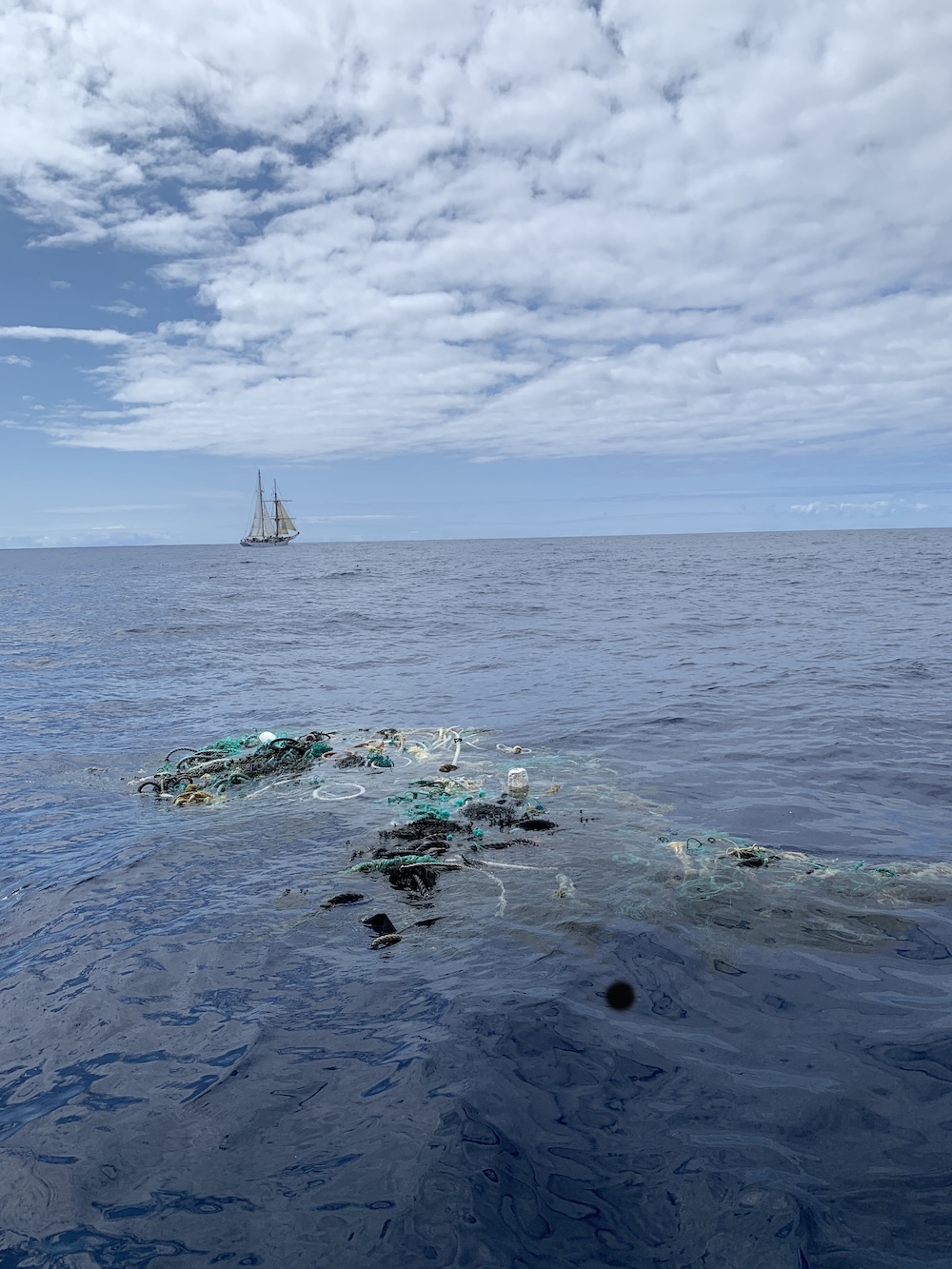
Plastic, Plastic Everywhere
M. Kelsey Lane, Ph.D. student, College of Earth, Ocean & Atmospheric Sciences
We were sailing in the Pacific Ocean on a research cruise studying marin debris far out in the 'Great Pacific Garbage Patch'. We had been looking for larger marine debris to investigate what sea life might colonize this unique, human-created floating habitat, but we hadn't found much larger debris yet. I was started to get worried the project wouldn't work. On this sunny, calm day, a lookout spotted a large mass of lines and floats on the horizon. We launched the small boat and a couple of us drove off to investigate. We found a massive snarl of old fishing debris, plastic bottles, and even a laundry hamper. I took this photo to capture the size of the marine debris - about the size of a small car - with our ship in the background. It was a bittersweet moment; we were excited to have found what we were looking for, but we realized we could not physically fit this much trash on our ship. We gathered as much as we could and then had to drive away and leave this marine debris to float and break down in the ocean. I took as many photos as I could to document it. Plastic is everywhere!

Mixtecs
Sharon Salgado Martinez, M.A. student, College of Liberal Arts
This is Soledad Cortés, an Indigenous Mexican Woman from Oaxaca, MX., at her business located in Newport, Oregon. She speaks Mixtec, Spanish, and English. She is a business owner of the only Latino store in Newport. Her store, named "La Juquilita," is where Latinos from all backgrounds come together; it is a place of reunion, memory, and tradition, as they can find plenty of products from their countries (México, Guatemala, Chile, Ecuador, Salvador). My research collects oral histories from indigenous Mexicans in Oregon, and the collection will be available in SCARC of OSU for present and future generations.

Ocean Eyes
Suzanne Winquist, M.S. student, College of Agricultural Sciences
You are staring into the eyes of a Black-footed albatross. Welcome to Midway Atoll. Maybe you’ve read about this place in your history books. A low-slung cluster of islands in the middle of the Pacific that played an outsized role in WWII. There is even a battle named after it. Well, things have changed out here and these islands are now protected within the Papahānaumokuākea National Marine Sanctuary. This history adds an element of the bizarre to the spectacle of a bustling albatross nesting colony. Millions of birds raise their young here; a new generation of fliers taking off on its defunct runways. Albatross do the work of raising a chick in shifts up to three weeks long. Pairs must be strongly bonded to weather these long sits at the nest, trusting that their mate will return. These bonds are formed and maintained over the years through elaborate courtship dances. You can see two Laysan’s albatross dancing in the background of this photo. The watchful Black-footed albatross in the foreground is perched atop a single egg, waiting for their mate to ride home on a stiff wind and punch in for their shift. I spent my two weeks on Midway looking for this moment of transition. The goal was to tape a GPS and radar detecting tag onto the outgoing bird before it set out to stretch stiff wings and follow the wind as far as the Aleutian islands. These devices track the bird's flight paths and ping radar from ships that birds encounter on their journey. These devices help researchers investigate how and where these birds interact with fishing vessels. I took this photo on a quick break in searching for switching pairs. I was arrested by these marvelous eyes that have seen so much more of the ocean than I ever will. All work conducted under permit.
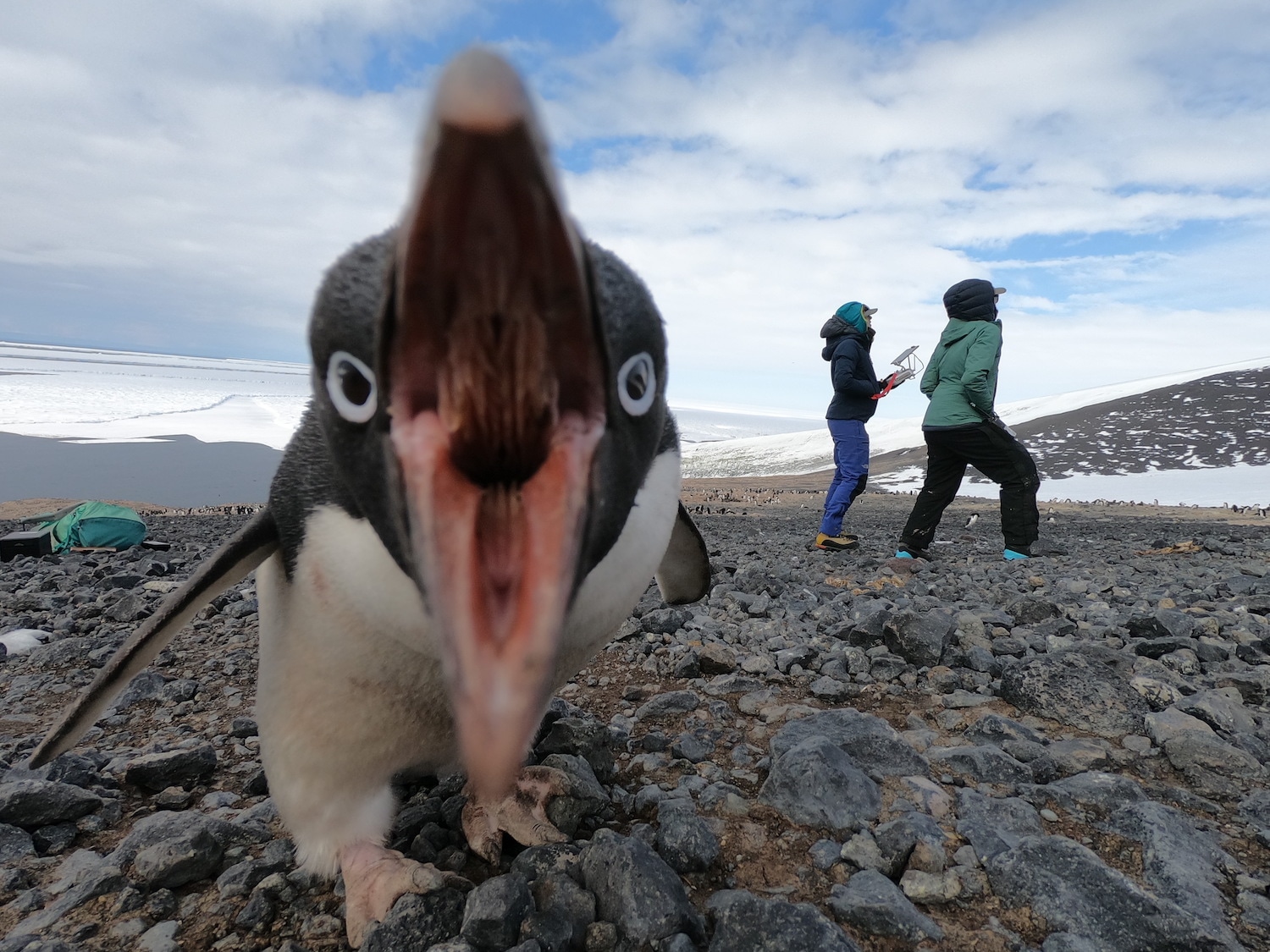
A Taste For Science
Suzanne Winquist, M.S. student, College of Agricultural Sciences
Here I am, flying a research drone at the edge of one of the largest and southern most penguin colonies in the world, Cape Crozier, Antarctica. I set out to capture footage of our team using drones to count the >650,000 Adélies that breed here. I position the GoPro, click it on, and focused on the work of flying. In trundles our main character. Adélie penguins like this one have no natural land-based predators and are quite curious. This one saw some long-legged creatures making a commotion and had time in his day to come investigate. Without hands for poking, these birds explore their world with their bills. It is not uncommon to have one of these characters sneak up behind us while we walk through the colony and tug on a pant leg, untie shoelaces, or knock over an unattended water bottle. My MSc research here at OSU relies on yet another type of camera. I use video loggers taped to the back of these birds to record their foraging behaviors. I spend hours reviewing these videos and recording each time the bird plucks a prey item from the water. The perspective of video-logger points over the back of the penguin’s head and straight into the eyes of a krill, fish, or other prey item as the penguin’s bill flicks up and snatches it. I love that the perspective is flipped in this photo. Now we all know the last thing those krill or fish might see. Photo credit goes to me. Credit for Artistic direction goes to Unnamed Adélie penguin.
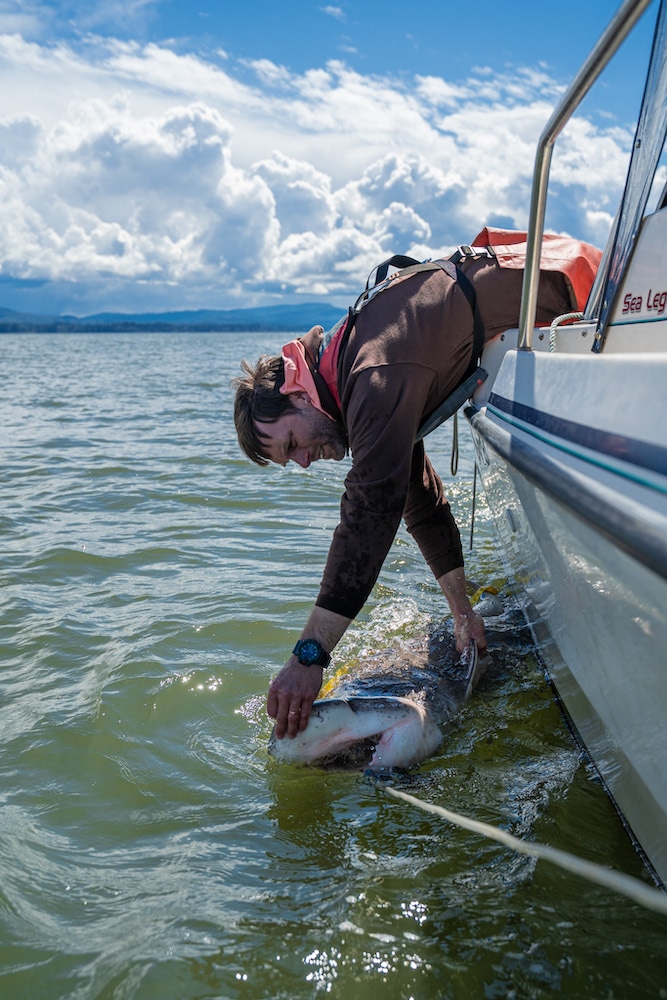
We're Gonna Need a Bigger Boat....and a Better Understanding
Jessica Shulte, Ph.D. student, College of Agricultural Sciences
What lies beneath the waters within the northern California Current System? Little is known about the roles that predators play within Oregon and Washington waters. What few studies have been done focused on orcas, sea lions, and shorebirds. However, sharks are abundant in our waters and likely play critical roles in interactions with economically, ecologically, and culturally important fisheries in the region. My research focuses on incorporating the broadnose sevengill shark – an abundant, large, apex predator along temperate coasts – into the understanding of our coastal marine ecosystems. These animals show up seasonally and in high numbers within shallow bays, but little more than that is known. My research focuses on tagging them with movement tracking devices and gathering foraging data to quantify their role. On a cool April day, we arrived in Willapa Bay, WA – a known sevengill haunt in the summer. But when do they actually show up? Unknown unknown unknown. We rode out to one of the deeper spots in the bay and dropped in our baited hooks. Wait wait wait. After a morning filled with rain and hail, the clouds parted, letting the bright sunshine through to warm us as we bobbed around on our boat. Suddenly: tug tug tug. I pulled up the line to reveal…a huge male sevengill! I rejoiced…they’ve arrived! Before we collected tissue samples, my advisor, Dr. Taylor Chapple, measured the length - 2.52 m (8.3 ft)! The largest sevengill I’d seen yet! Sevengill science season has officially begun. Happy happy happy.
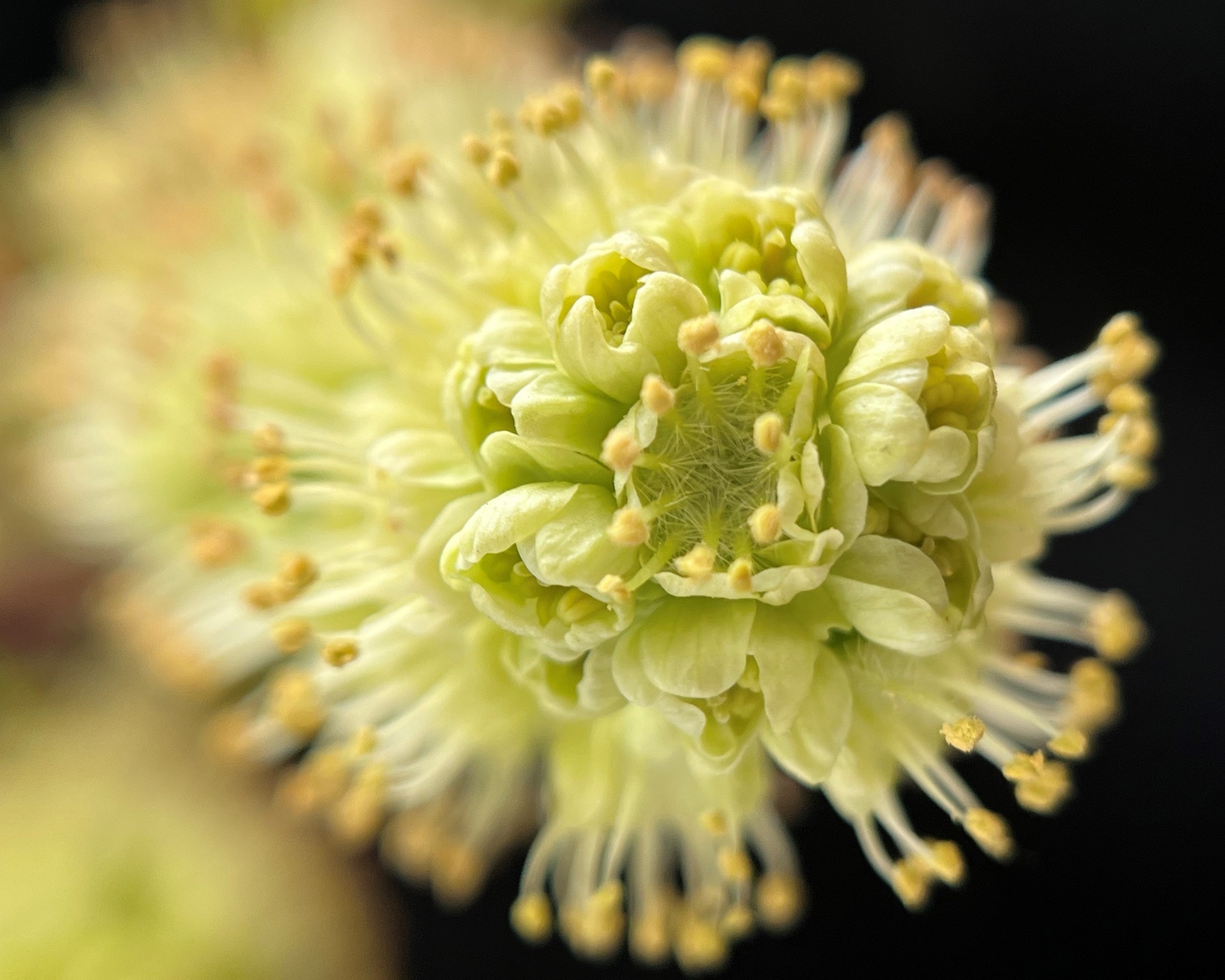
Bigleaf Maple Flower in Bloom, Under 10x Magnification
Melanie Douville, M.S. student, College of Liberal Arts
As anyone who has tried to remove one may tell you, bigleaf maples are a tenacious tree. It is built for this landscape. The large, lush leaves blanket the canopy, and its exuberant flowers are among the earliest and largest to bloom (to many pollinating insects’ and beekeepers’ delight). Not only can you make maple syrup from a bigleaf, but you can eat its flowers too! They make great tempura and fritters. Native to the Pacific Northwest, bigleaf maples (Acer macrophyllum) are cousins to the traditional syrup producer, sugar maples (Acer saccharum). Preliminary findings from our OSU team suggests nutrients may be significantly higher in bigleaf than sugar maple sap, likely giving it its rich, complex flavor reminiscent of the Willamette Valley and coastal mountain ranges it thrives in. The bigleaf is an integral member of riparian ecosystems. It recycles nutrients and absorbs heavy metals such as iron, asbestos, and lead from groundwater, helps prevent erosion, and is a robust carbon capturing tree. Growing up in rural Oregon, I am deeply invested in the care and celebration of our forests. Inspired by public communicators who bridge the gap between art and science, I saw an opportunity to embrace interdisciplinarity and study art and science communication at OSU’s premier research College of Forestry. Through my work as a research assistant for OSU’s bigleaf sap-tapping project, I hope to inspire new appreciation for our common native species and all they have to offer.

Beneath the Ice
Kirsten Steinke, Ph.D. student, College of Earth, Ocean & Atmospheric Sciences
On a brisk winter morning in July, we head out on one of our reliable Zodiacs in search of the animal that fuels the Antarctic ecosystem: krill. Antarctic krill are small crustaceans (at most about the length of your pinky finger) that move around in large swarms in an attempt to avoid predation by seals, penguins, seabirds, fish and whales. Despite the fact that krill sustain predator populations and a rapidly growing global fishery, they are resilient and have discovered ways in which to adapt to increasing anthropogenic disturbances and climate change. While their adaptive capabilities are still not fully understood, their ability to survive is noteworthy and is evidenced by the fact that the biomass of this one species is greater than the biomass of all the humans on Earth combined! We push the encroaching sea ice out of our way and maneuver through the sea of icebergs, thinking about the best way in which to deploy our nets in an attempt to capture both krill, and copepods—their zooplanktonic prey. With the wind approaching gale speeds, catching these critters is not easy. The krill are elusive and unwilling to be captured, but the trip is not a total loss. We head back to station with jars full of copepods to feed the krill that we are keeping in tanks. Doing research in Antarctica taught me to be resilient, like the krill, as I soon realized the importance of having a backup plan when things get a bit d(icey).

Shades of Hemp Production
Alexander Gregory, M.S. student, horticulture
It's safe to say that interest in US hemp production is growing, but what exactly does it take to produce the best hemp crop? Because legal hemp production has been underway in the United States for less than ten years, many fundamental questions like 'how much water should I apply to my plants to maximize quality and growth?' remain unanswered. The hemp water-use trial conducted at the Hermiston Agricultural Research and Extension Center (HAREC) applied different rates of irrigation to several varieties of hemp to assess the effect water availability has on plant size, flower weight, cannabinoid concentration, scent, and even color. Under the direction of OSU's Global Hemp Innovation Center (GHIC) the data collected from this and several other sites across Oregon represents one of the first steps towards creating research-based recommendations for farmers as they continue to increase the area of land dedicated to hemp production. Water use represents just one of the many aspects of hemp cultivation that needs to be addressed in order to support hemp cultivation in the US. Hemp trials assessing fertilizer rates, pesticide effectiveness, row spacing, and many other foundational aspects of agriculture are currently underway. By developing the baseline recommendations required to successfully produce a high quality hemp crop, researchers can begin to support grower success in much the same way as has been done in corn, wheat, and virtually all other traditional crops for decades.

A Sense for Change
Ashley Hann, M.S. student, marine resource management
As we completed a day of research in the Palmer Deep Canyon region of the Western Antarctic Peninsula, I gazed off the back of our small vessel on our way back to station. Despite the often hostile and extreme conditions associated with Antarctica, Palmer Deep Canyon is known for the concentration of life that inhabits the area, ranging from microscopic plankton to mammoth whales. We were conducting research to understand how the physical features of the region influence and drive the life there. On our biweekly research surveys, in which we measured things like water temperature and were on the lookout for animals, the conditions varied significantly across the region and between days. On this particular day, our survey started out stormy with waves, wind, and rain, but had ended with clear skies and glassy waters. How did the variability we experienced at the surface influence life at depth? Were certain conditions preferred by certain species? By deploying equipment, like the net stored on the back deck railing in this photo, we are able to get a sense of the conditions and how the life of the region responds throughout the water column to change. The Western Antarctic Peninsula at-large has experienced some of the most intensified warming of anywhere on Earth in recent years. Researching what drives life in such regions and how that life responds to change can improve our understanding of regional and global changes to come.

Unexpected Interactions
Heather Fulton-Bennett, Ph.D. candidate, integrative biology
Most people looking into a tide pool see the sea urchins, the snails, the fish... But what about those bright pink crusts? Those are coralline red algae, of no relation to corals, but of great importance to marine communities. Found from polar kelp forests to tropical coral reefs, coralline algae provide food and habitat for many species, including corals and sea urchins. However, this isn't their only role. Coralline algae also release a chemical cue that induces the larvae of many invertebrates to settle from their free-floating planktonic stage to their crawling adult form. Along Oregon's coast, chitons, abalone, sea urchins, and limpets all rely on coralline algae in one or more ways. As our ocean warms and becomes more acidic, coralline algae are likely to decline, possibly up to 90%, due to the increasing stress of these conditions. One of the reasons these algae have been so successful is their calcium carbonate skeleton that protects them from grazers, waves, and tumbling rocks. Unfortunately, this calcium carbonate structure also makes them very susceptible to ocean acidification, as the process to secrete calcium carbonate becomes increasingly energetically expensive. This negative affect on coralline algae will likely have cascading effects through the organisms that rely on them for food, habitat, and settlement cues. In coral reefs, ocean acidification led to a significant decrease in successful coral settlement to coralline algae, and we may see a similar effect in colder waters as the settlement cue is affected and coralline populations decline.
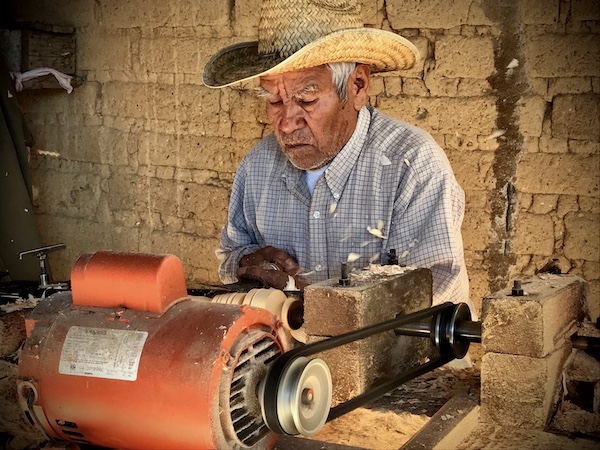
The Molinillo Maker
Gretchen Engbring, Ph.D. candidate, forest ecosystems & society
While conducting interviews in the Mexican state of Oaxaca, my colleague and I followed a mechanical humming to a small adobe workshop perched on a forested hilltop in the neighborhood of “Las Ánimas”. The workshop's sole occupant was narrowly focused on his profession of over 50 years: crafting wooden whisks called “molinillos”. In an interview conducted over the sound of the whirring motor, we were told the molinillo maker was one of many residents whose livelihood was inextricably linked to the community-owned and managed forests we studied. At the end of the interview, I purchased a molinillo and thanked its creator, looking forward to the many cups of frothed hot chocolate the wooden tool would make. “Do you know what Las Ánimas means?” my colleague asked me as we walked away through the dappled shade of the pines. I shook my head, the buzz of the workshop fading in the distance. “It means 'the souls'”, he said. Fitting, I thought, for the people who made the forests where I conducted my fieldwork feel so alive.

Little Salamander, Big Impact
Christopher Cousins, Ph.D. student, wildlife science
Columbia torrent salamander (Rhyacotriton kezeri) perched on a mossy streamside log looks out over his domain, facing an uncertain future. This species of salamander is only found in the Pacific Northwest, where it inhabits cold, fast-flowing headwater streams. Habitat loss and climate change are threatening the survival of this species, and this photograph was taken during surveys gathering information to assist with the decision to place it on the United States Endangered Species list. Don't let its small size deceive you, this species plays an important role in the ecosystem it inhabits! This amphibian is active both in the streams and riparian forest, making it an important link in the flow of nutrients between the two habitats. Many of the streams that they live in are fishless, and as a result salamanders are the ecologically dominant vertebrates in these streams. By consuming insects and arthropods, salamanders can have large impacts on the macroinvertebrate community. Many of the animals that they eat feed on leaf litter and other organic matter that stores carbon which would otherwise escape into the atmosphere, contributing to global warming. Less salamanders means more macroinvertebrates and less organic matter, and that could have a strong effect on climate change. My research seeks to discover the ecological role that salamanders have on their ecosystem in Pacific Northwest forests. By giving tangible ecological values to these amphibians, we can better understand what the forests would be like without them, and how the rippling effects would change our world.